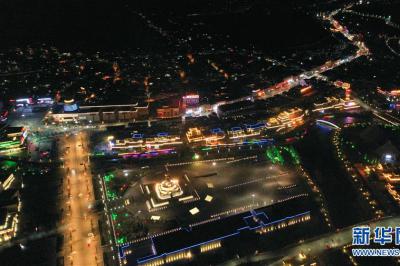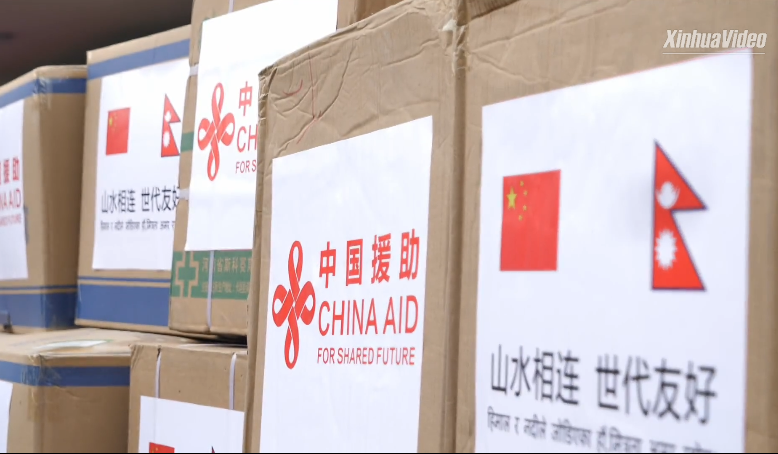 Photo shows the new Gesang Small Town in Naocong Village, Yushu Tibetan Autonomous Prefecture, Qinghai Province, which was renovated after the earthquake. (Xinhua/Zhang Long)
 Photo shows Caiwa, chief of the third group of Zhaxi Datong Village, Yushu City, Yushu Tibetan Autonomous Prefecture, Qinghai Province, watches villagers train horses in Zhaxi Kesai Horse Training Field. (Xinhua/Zhang Hongxiang)  Photo shows a view of Yushu City, Yushu Tibetan Autonomous Prefecture, Qinghai Province on April 6. (Xinhua/ Wu Gang)
 Photo shows Suonan Yongji, doctor at the Bayi Hospital of Yushu Tibetan Autonomous Prefecture, Qinghai Province, is on duty on March 28. (Xinhua/ Zhang Long)
 Photo shows a monk goes through an underpass close to the Gesar Square, Yushu City, Yushu Tibetan Autonomous Prefecture, Qinghai Province on April 6. ( Xinhua/ Wu Gang)
 Photo shows the national costume workshop in Jiajiniang Community, Yushu Tibetan Autonomous Prefecture, Qinghai Province on April 3. (Xinhua/ Zhang Long)
 Photo shows the panorama of Jiegu Temple in Yushu Tibetan Autonomous Prefecture, Qinghai Province. (Xinhua/ Wu Gang)  Photo shows Zhaxi Datong Village, Yushu City, Yushu Tibetan Autonomous Prefecture, Qinghai Province on April 6. (Xinhua/ Wu Gang)
 Photo shows a sanitation worker cleans a square in Zhaxi Datong Village, Yushu City, Yushu Tibetan Autonomous Prefecture, Qinghai Province on April 6. (Xinhua/ Wu Gang)
 Photo shows students play during class break in Bayi Orphan School in Yushu Tibetan Autonomous Prefecture, Qinghai Province on April 3. (Xinhua/Zhanglong)
 Photo shows Qiuyong Zangga, a second grader in the Third Wanquan Primary School in Yushu City, is in class on April 9. (Xinhua/ Zhang Hongxiang)
 Photo Shows trees in Yushu City, Yushu Tibetan Autonomous Prefecture, Qinghai Province. (Xinhua/ Xue Yubin)
 Photo shows people clean the trimmed branches in the Experimental Base for Plateau Trees Planting in Yushu Tibetan Autonomous Prefecture, Qinghai Province on March 29. (Xinhua/ Zhang Long)  Photo shows people plant seedlings in the Experimental Base for Plateau Trees Planting in Yushu Tibetan Autonomous Prefecture, Qinghai Province on March 29. (Xinhua/ Zhang Long)
April 17,2020 -- Yushu Tibetan Autonomous Prefecture in northwest China’s Qinghai Province was severely hit by a grave earthquake on April 14, 2010. Ten years has passed, and the quake-hit plateau region has regained its vitality, witnessing a miracle-like rebirth.
Chinese speed creates miracle in Yushu
It was crowded with makeshift tents ten years ago, but now we can race horses here again, said Caiwa, chief of the third group of Zhaxi Datong Village in Yushu city.
After the disaster, life has returned to normal but memory still lingers on. Caiwa clearly remembers the sudden shake of the world, the collapse of buildings and the shouts for help here and there.
The quake came without any warning. It spread to a range of 35.8 thousand square kilometers, resulting in 2,698 deaths and 270 people missing.
Time is life. A series of numbers show the miracle of Chinese speed:
——7,856 people were rescued from the ruins within 72 hours after the earthquake, among which 6,761 people were alive;
——225,000 people were transferred to safe places;
——Transfer 3,109 severely wounded people for better treatment mainly by aircraft;
——Set up over 25,000 tents to help quake-hit people settle down within one week;
——Allocate thousands of tons of disaster relief materials and equipment;
——More than 188,000 people got subsidies;
——Key facilities like water and electricity supplies and roads were restored within 5 days after the quake.
The first rescue team arrived in Yushu in less than 8 hours after the earthquake took place, said Gezha, the then secretary general of the Red Cross of Yushu Tibetan Autonomous Prefecture.
Chinese strength empowers a renovated Yushu
China invested 44.754 billion for the rebuilding of Yushu, 8 times more than the total investment from the year of 1951 to 2009.
A total of 1,248 reconstruction projects have been launched during the first three years after the earthquake, making sure to meet all the basic needs of quake-hit people. 16,710 households of farmers and herdsmen and 22,439 households of urban residents have moved to new houses.
The reconstruction work in Yushu was not easy. Many workers suffered from altitude sickness due to the high altitude, the small hydropower stations which were used to generate power were destroyed, and many roads were also blocked.
However, Chinese strength made all these work possible. The main building of the First Ethnicity School of Yushu County was rebuilt in 53 days, which means workers built one floor in every four days. What a miracle!
The State Grid Corporation of China invested over 5 billion yuan in building a modern electricity network in Yushu, making the electricity network cover altogether 46 towns and 155 villages in Yushu.
Caring for people makes Yushu a happy homeland
Daige Village, which was badly destroyed in the 2012 earthquake, was relocated and has become a science and technology demonstration village. Villagers moved to newly built Tibetan-style houses with solar panels on the roofs. The new houses are equipped with floor heating systems.
With more roads being built in the village, life has become more convenient. Villagers also build greenhouses to plant vegetables. Ouzhu Yongzang said life here is convenient and comfortable with no big differences with that in cities.
During the ten years after the disaster, Yushu Tibetan Autonomous Prefecture kept allocating over 75% of the financial funds on improving people’s livelihood.
Yushu has reduced the poverty incidence rate from 34% to less than 3% in the past five years, realizing the goal of eliminating absolute poverty.
Pursuing win-win results makes Yushu a green homeland
Hoh Xil, as an important habitat for Tibetan antelopes, became the first World Natural Heritage Site on the Qinghai-Tibetan Plateau in July, 2017.
Protecting wild animals is the daily work for Longzhou, a guardian of Hoh Xil. Experiencing the harsh living environment, he and his teammates spent the past ten years protecting this place.
With relentless efforts, a variety of wild animals such as Tibetan antelope, snow leopard, black-necked crane, and wild yak have witnessed an obvious growth in population.
Balancing environment and economic developments, putting the ecological protection as top priority and making sure people live a better life are exactly what we should do, said Cairangtai, governor of Yushu Tibetan Autonomous Prefecture.
The new-born Yushu is a miniature of China’s development, said Zhaxi Cairang, deputy governor of Yushu prefecture and mayor of Yushu city.
By:Jia Puyu
|
- Home
- News Tibet |Exclusive |China |World |Other Tibetan-Inhabited Area |Tibet through the Eyes of Foreigners |Related News
- Documents White Papers |Others
- Photo Politics |Economy & Society |Culture & Religion |Human & Nature |Beautiful Tibet |Other Tibetan-Inhabited Area |Exchanges |Related
- Video News |Documentary |Micro-Video |Entertainment
- Art
- Tourism
- In Focus
- About Tibet






